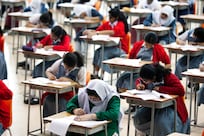It might be the most dynamic region in the world but the Asia-Pacific isn’t meeting its economic potential, and some of that has to do with gender equality, according to the McKinsey Global Institute.
Targeted policies to achieve more women’s equality in Asia-Pacific economies could add $4.5 trillion to the region’s combined annual gross domestic product by 2025, or 12 per cent better than if the status quo were maintained, MGI, the business and economics research arm of McKinsey & Co, said in a report last week.
“Women can help - and are helping - to power this engine, making vital contributions to sustaining and enhancing Asia’s growth and lifting more people out of poverty,” the report’s authors wrote, according to Bloomberg. “Yet gaps remain large in many countries in the region on gender equality both in work and in society.”
The researchers estimate that 58 per cent of that potential growth would be from raising women’s labour-force participation rate, a quarter from putting more women to work in higher-productivity sectors and 17 per cent from boosting women’s work hours.
MGI judged 18 economies in the region for gender equality in work and in society. On the work metrics, the Philippines was lauded for progress, followed by New Zealand and Singapore. India and Pakistan were judged furthest from gender parity in work.
Grant Thornton International's Women in Business survey published in March shows that 46.5 per cent of those holding senior management posts in the Philippines are women, a proportion that is way above the global average of 24.1 per cent.
That compares to 40 per cent in 2017 and 39 per cent in 2016.
The authors of the report, which surveyed 4,500 senior executives across 35 countries, said the country’s top rank could be attributed to policies and practices such as equal pay for men and women performing the same roles, among others. Up to 80 per cent of those surveyed cited this factor as the reason, the report said.
The survey also attributed the country’s ranking to non-discriminatory policies for recruitment (cited by 76 per cent of respondents), paid parental leave (70 per cent), and flexible hours (66 per cent).
_______________
Read more:
Five decades after the debate on equal pay began in the UK, the discussion still rumbles
Draft law brings UAE closer to ensuring equal wages for men and women
_______________
“These practices have been introduced by Filipino businesses in order to attract and keep employees, enhance company performance, comply with government legislation, live up to organisational values and meet the expectations of wider society,” Grant Thornton said.
While there are fewer than four women globally in leadership roles to every 10 men, the ratio is only one in four in the Asia-Pacific region, according to the report. On societal metrics, South and South East Asia offers a lot of potential for gender parity in digital and financial inclusion, while physical security and autonomy are considered greater worries, Bloomberg said.
MGI’s calculations focus on supply-side estimates that account for labour-force participation rates by gender and age cohorts, part-time versus full-time work among men and women and employment patterns for men and women across sectors. The authors note that the supply-side approach needs demand-side policies, including those that would help create jobs that attract female workers.
Women account for half of the combined Asia-Pacific population but contribute just 36 percent of the $26tn in gross domestic product - the same as the global share, the report showed.
And while the region as a whole has shown “significant progress” on gender equality over the past decade - including on maternal health and adult literacy -- much improvement is needed on boosting women’s workforce participation, according to the report. That’s one of five metrics the group used to measure gender equality at work.
While Singapore has shown high marks on this count, boosting female participation to 58 per cent in 2016 from 28 percent in 1970, even the city state’s relatively progressive policies haven’t prevented a wide gender gap in areas such as hours worked and productivity.
The MGI authors suggest that encouraging women’s participation in the so-called STEM fields -- science, technology, engineering and math -- and addressing skills shortages should help alleviate Singapore’s gender inequality.






